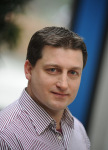
Aldrik Velders (1970) studied Chemistry at the University of Utrecht (NL) with Prof. Blasse and Prof. Andries Meijerink, and at the Universityof Pavia(I) with Prof. Luigi Fabbrizzi. In 1995 he started as graduate student at the University of Leiden (NL) on antitumor chemistry with Prof. Jan Reedijk, was visiting scientist in the group of Prof. Enzo Alessio in Trieste(I), and obtained his PhD degree in 2000 with the thesis Ruthenium Complexes with Heterocyclic Nitrogen Ligands. He spent his post-doc years at the Centre for Magnetic Resonance under guidance of Prof. Bertini and Prof. Luchinat (Florence, I) and as Marie Curie Fellow at Molteni Farmaceutici (Scandicci, I). In 2004 he started as assistant professor in the SupraMolecular Chemistry and Technology group of prof. David Reinhoudt at theUniversity of Twente, also heading the NMR & MS department. Since 2009 he is associate professor and currently in the BioMedical Chemistry group. His research interests go from (dynamic) supramolecular chemistry in solution and on (flat, fluidic and functional nanoparticle) surfaces, to (bio)nanotechnological applications of microfluidics, fluorescence and NMR spectroscopy. He recently moved to Wageningen University where he is the chair of BioNanoTechnology group and has a major research line focused on further continuing to develop microfluidic NMR hardware and Nano-NMR spectroscopy. In July 2011, the management board of the University of Castilla-La Mancha approved the entitlement of “profesor colaborador honorifico”, allowing him to become member of the Microwave and Sustainable Organic Chemistry group. Since July 2013 he is the director of the Wageningen Nuclear Magnetic Resonance Centre (WNMRC).
Research interests as a member of the MSOC group.
One of my major areas of interests regards “Nano NMR Spectroscopy”. NMR spectroscopy is among the most powerful analytical tools developed in the last century, but it has, yet, only played a minor role in the emerging fields of micro- and nanotechnology. NMR spectroscopy is nevertheless a powerful tool also in these new research areas, which for example we have exploited for the analysis of nanoparticles and nanoliter sample volumes.
Non-functionalized nanoparticles are notoriously hard to characterize, but in collaboration with prof. Richard Crooks from the University of Texas at Austin (TX, USA) some useful strategies have been developed. In particular, we have used high-resolution solution-state NMR spectroscopy to characterize the structure of non-functionalized Pd dendrimer-encapsulated nanoparticles (DENs). Hereto, first, a full analysis was done of the homo- and heteronuclear 1D and 2D NMR data of the fourth-generation hydroxyl-terminated poly(amidoamine), PAMAM, dendrimer (G4‑OH), which is a 15 kDa macromolecule containing over a 1000 protons that show severely overlapping signals due to the high (pseudo-)symmetry. Analyzing G4‑OH(Pd55) DENs by 1H and diffusion-ordered NMR spectroscopy then unambiguously demonstrates that single nanoparticles are encapsulated within individual dendrimers.[1] Consecutively, simple 1D 1H‑NMR data of Pd nanoparticles encapsulated within sixth-generation hydroxyl-terminated PAMAM (a 60 kDa dendrimer) allows determination of the size of Pd DENs (G6-OH(Pdx)) ranging from 55, 147, 200 to 250 atoms. Solution-state 1H NMR spectroscopy thus provides a straightforward tool to characterize nanometer-size nanoparticles,[2] where otherwise advanced and less accessible techniques, e.g. TEM, have to be used, that moreover only provide sampled and ex-situ data.
Analysis of mass-limited samples with NMR spectroscopy remains a major challenge, which has triggered the development of expensive and technologically demanding solutions as cryogenically cooled coils in so-called cryoprobes and hyperpolarization strategies. A relatively cheap alternative approach regards the use of miniaturized coils and, over the past two decades, microcoils of different geometries have in fact proven to be a successful sensitivity enhancement strategy.[3] We are particularly interested in microfluidic chip designs with planar spiral coils and detection volumes in the lower nanoliter range. These NMR chips have proven to be very efficient for on-flow reaction monitoring studies by 1H NMR spectroscopy, optimizing reaction conditions utilizing only minute amounts of starting material and solvents.[4] Alternatively, under static conditions also supramolecular interactions can be investigated as proven by a 19F NMR study on the interaction of hexafluorophosphate anions with cyclodextrin host molecules.[5] We are currently exploring the use of the microcoil-on-a-chip concept for low-gamma nuclides as well, and integrate the chips in more complicated hyphenated microfluidic set ups.
Selected References:
[1] M.V. Gomez, J. Guerra, A.H. Velders, R.M. Crooks, J. Am. Chem. Soc., 341–350 (2009). [2] M.V. Gomez, J. Guerra, V.S. Myers, R.M. Crooks, A.H. Velders, J. Am. Chem. Soc., 14634–14635 (2009). [3] R. M. Fratila, A. H. Velders, Annu. Rev. Anal. Chem. 2011, 227-249 [4] M.V. Gomez, H.J.J. Verputten, A. Díaz-Ortíz, A. Moreno, A. de la Hoz, A.H. Velders, Chem. Commun. 2010, 4514-4516 [5] M. V. Gómez, D. N. Reinhoudt, A. H. Velders, Small 2008, 4, 1293-1295.
ORCID iD